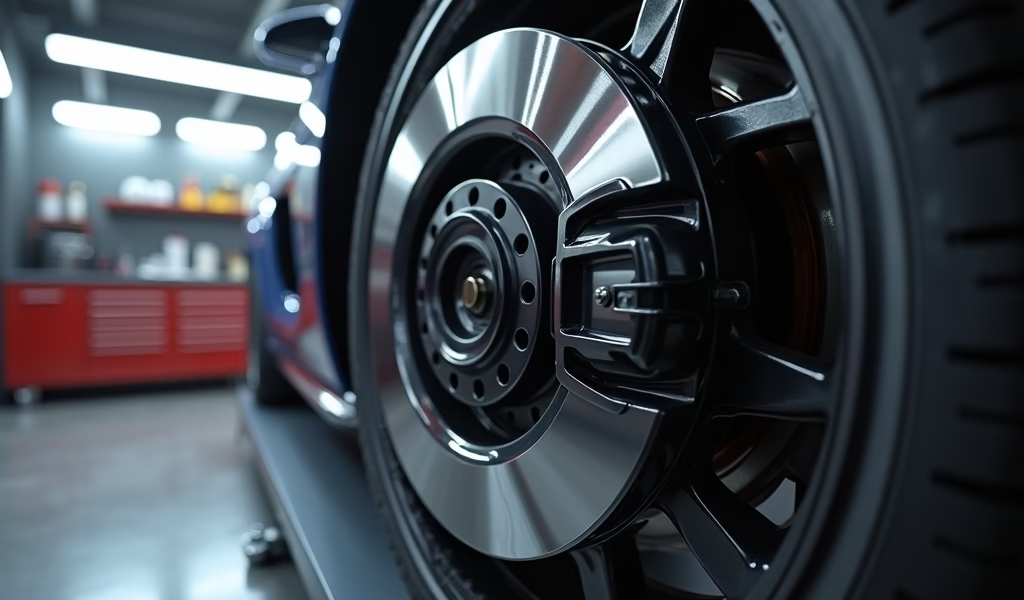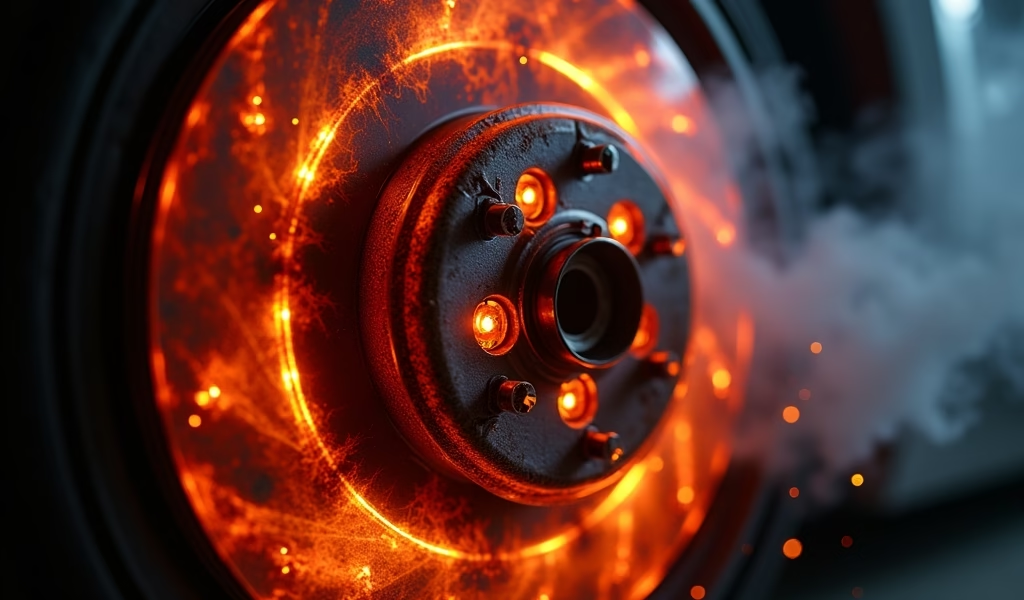Overview
This article explains why brake disc ventilation is critical for vehicle safety and performance, detailing three main design types (straight vane, curved vane, and pillar vane) and their respective benefits. It offers practical advice on selecting the right ventilation design based on driving habits, highlights the importance of proper materials and maintenance, and emphasizes that effective brake cooling ensures consistent stopping power and extends component life.
Table of Contents
- The Heat Factor: Why Brake Disc Ventilation Matters
- Understanding the Cooling Crisis Under Your Wheels
- The Big Three: Common Ventilation Design Types
- Tip #1: Straight Vane Design – Simple Yet Effective
- Tip #2: Curved Vane Design – The Performance Champion
- Tip #3: Pillar Vane Design – The Modern Solution
- Tip #4: Material Matters – Choosing the Right Alloy
- Tip #5: Maintenance Secrets for Longevity
- Conclusion: Keeping Your Cool on the Road
- Frequently Asked Questions
The Heat Factor: Why Brake Disc Ventilation Matters
Picture this: you’re cruising down a mountain pass, enjoying the scenery when suddenly a deer jumps out. You slam on the brakes, and in that moment, your life depends on a piece of engineering most folks never think twice about – your brake disc ventilation design.
Hey there, fellow road warrior! Let’s have a chat about something that might sound boring at first but could literally save your bacon: brake disc ventilation design. I’ve been elbow-deep in brake systems for over 15 years, and let me tell you – these unsung heroes deserve more credit than they get.
When you hit those brakes, you’re essentially converting your vehicle’s kinetic energy into heat – and we’re talking serious heat, folks. Like “fry an egg on the sidewalk” times ten! Without proper ventilation, those discs would get hot enough to compromise your braking performance exactly when you need it most.
In the next few minutes, I’ll walk you through five pro tips about brake disc ventilation design that’ll not only help you understand what’s stopping your ride but might also save you some serious cash on repairs down the road. So grab a coffee, and let’s dive into the world of cooling technology that sits right behind your wheels.
Understanding the Cooling Crisis Under Your Wheels
Let’s break this down into something relatable. Imagine running a marathon in a thick wool sweater on a summer day. Sounds miserable, right? That’s essentially what’s happening to poorly ventilated brake discs during heavy braking. They’re working hard with no way to cool down.
Brake discs can reach scorching temperatures of up to 1,200°F (650°C) during intense braking sessions. That’s hot enough to make cast iron glow! When your brake system hydraulic pressure pushes those pads against the rotor, all that friction generates massive heat.
Without proper ventilation channels, this heat becomes trapped, leading to a phenomenon we mechanics call “brake fade.” It’s like trying to stop a rolling bowling ball with a stick of butter – the hotter things get, the less effective your brakes become. Not exactly what you want when you’re barreling down a steep highway!
According to research from the Society of Automotive Engineers, effective brake disc ventilation can improve cooling efficiency by up to 40%. That’s the difference between stopping confidently and having a white-knuckle moment of terror.
The cooling crisis gets even more complicated when you consider that most modern vehicles are getting heavier (thanks to added safety features and technology), while wheel sizes are often getting larger for aesthetic reasons. This creates a perfect storm where we’re asking brakes to work harder while potentially giving them less airflow to cool down.

The Big Three: Common Ventilation Design Types
Before we jump into our pro tips, let’s get familiar with the main players in the brake disc ventilation game. Think of these designs as different cooling strategies, each with its own personality and set of skills – kind of like choosing between air conditioning, ceiling fans, or open windows for your house.
There are three primary ventilation designs you’ll encounter in the wild:
- Straight vane design: The old reliable – simple passages running straight from the center to the edge
- Curved vane design: The performance athlete – curved channels that actively pump air as the disc spins
- Pillar vane design: The modern compromise – pillars or posts connecting the friction surfaces
Each of these designs represents a different approach to the same problem: how to let your brakes breathe. The right choice depends on your driving style, vehicle weight, and performance expectations. A heavy-duty truck has different cooling needs than a zippy sports car, just like a chef needs different kitchen ventilation than a home cook.
Now, let’s dig into our five pro tips to help you understand the nuances of brake disc ventilation design and how to make the smartest choices for your vehicle.
Tip #1: Straight Vane Design – Simple Yet Effective
Let’s start with the classic: straight vane design. Imagine these as the straight hallways of a building – direct and to the point. Air travels from the center of the rotor outward in a straight shot, carrying heat along with it.
The beauty of straight vanes lies in their simplicity and cost-effectiveness. They’re like the reliable work boots of the brake world – not flashy, but they get the job done. For most daily drivers and moderate-weight vehicles, straight vane designs offer perfectly adequate cooling.
Here’s what makes straight vanes a solid choice:
- Easier and less expensive to manufacture
- Less prone to cracking under thermal stress
- Simpler to balance, which means less vibration
- Generally more durable for everyday driving conditions
The downside? They’re not as efficient at pumping air as their curved cousins. Think of it like the difference between a box fan and a high-tech air circulator. Both move air, but one’s designed specifically to maximize airflow.
If you’ve got a family sedan or commuter vehicle that rarely sees aggressive driving, the rotor hat height measurement and straight vane configuration will likely serve you well for thousands of miles without complaint.
Tip #2: Curved Vane Design – The Performance Champion
Now we’re getting into the fancy stuff! Curved vane designs are the sports cars of the ventilation world. Their curved channels create a centrifugal pumping action as the disc spins – actively pulling cool air in and forcing hot air out.
Picture a water wheel at an old mill. As it turns, it doesn’t just passively let water flow through; it actively scoops and moves it. That’s what curved vanes do with air. This pumping action can improve cooling efficiency by 30-40% compared to straight vanes, according to Brembo’s technical research.
The advantages of curved vane designs include:
- Superior heat dissipation during repeated heavy braking
- Better resistance to brake fade on long descents
- Improved overall braking performance in high-stress situations
- Ideal for performance vehicles, track days, and mountain driving
The trade-offs? They’re typically more expensive to manufacture and can create directional rotors that must be mounted specifically on either the right or left side of the vehicle. Installing them backward is like trying to paddle upstream – you’re working against the design instead of with it.
If you drive a performance car or frequently tackle mountainous terrain, the investment in curved vane technology can pay dividends in braking confidence and component longevity. Your disc brake caliper piston area works in harmony with these vented rotors to deliver consistent stopping power.
Tip #3: Pillar Vane Design – The Modern Solution
The newest kid on the block is the pillar vane design, and it’s like the Swiss Army knife of brake ventilation. Instead of continuous vanes, these discs use pillars or posts to connect the two friction surfaces while allowing air to flow through in multiple directions.
Think of pillar designs as the open-concept floor plan of the brake world. Rather than being constrained to hallways (straight vanes) or curved pathways, air can move more freely throughout the entire disc. This design emerged as engineers sought the cooling benefits of vented discs without some of the manufacturing and structural challenges.
The pillar vane approach offers several unique benefits:
- More even heat distribution across the entire disc surface
- Reduced thermal distortion and warping
- Non-directional design (can be mounted on either side)
- Often lighter weight than traditional vaned discs
These advantages make pillar vane designs increasingly popular in modern vehicles, especially where weight reduction is a priority. Many NHTSA studies on vehicle lightweighting have highlighted brake components as an area where smart design can reduce unsprung mass without compromising safety.
If you’re replacing brake discs on a newer vehicle or looking to upgrade an older one with more modern technology, pillar vane designs offer an excellent middle ground between performance and practicality.

Tip #4: Material Matters – Choosing the Right Alloy
Let’s talk metallurgy for a minute – don’t worry, I’ll keep it simple! The material your brake discs are made from is like the difference between a cast iron skillet and an aluminum pan. They both cook your food, but they handle heat very differently.
Most standard brake discs are made from grey cast iron, which offers a good balance of heat absorption, dissipation, and cost-effectiveness. It’s like the cotton t-shirt of brake materials – reliable, gets the job done, and won’t break the bank.
For performance applications, you might encounter:
- High-carbon cast iron: Better thermal stability and resistance to cracking
- Carbon-ceramic composites: Exceptional heat handling but at a premium price
- Aluminum-iron composites: Lighter weight with good heat dissipation
Here’s my pro tip: material and ventilation design work hand-in-hand. The best ventilation design in the world won’t save a poor-quality disc, and even the finest materials need proper cooling channels to perform at their best.
For most daily drivers, a quality high-carbon cast iron disc with appropriate ventilation for your driving style is the sweet spot. Save the exotic carbon-ceramics for your dream Porsche – unless you enjoy spending money on parts that most people will never see!
Tip #5: Maintenance Secrets for Longevity
Now that you’re practically a brake disc ventilation expert, let’s talk about keeping those cooling channels working at peak efficiency. Even the best-designed system can get gunked up over time, like air ducts in an old house.
Here’s my maintenance checklist to maximize the lifespan of your vented brake discs:
- Regular visual inspections: Look for cracks, excessive rust, or debris in the ventilation channels
- Avoid prolonged sitting: When a vehicle sits for months, rust can form inside the ventilation channels
- Proper break-in procedures: New rotors need a proper bedding process to establish an even transfer layer
- Clean wheels: Believe it or not, cleaner wheels allow better airflow to your brakes
- Flush brake fluid regularly: Old fluid can contribute to corrosion inside the system
One often overlooked maintenance tip: if you frequently drive on salted winter roads, give your brakes some extra attention come spring. A thorough cleaning can remove corrosive salt deposits from those ventilation channels before they cause permanent damage.
Remember, brake disc ventilation is a bit like your home’s HVAC system – it works silently in the background until it doesn’t. A little preventive maintenance goes a long way toward avoiding costly repairs and maintaining optimal braking performance.
Conclusion: Keeping Your Cool on the Road
We’ve covered a lot of ground in our journey through the world of brake disc ventilation design. From straight vanes to curved channels, pillar supports to material considerations – it’s clear that these seemingly simple components involve some serious engineering.
Think of your brake disc ventilation system as the unsung hero of your vehicle’s safety features. While airbags and seatbelts get all the glory, it’s those carefully designed cooling channels that ensure your vehicle can stop reliably time after time.
Whether you’re choosing replacement parts for your daily driver or upgrading the brakes on your weekend warrior, understanding ventilation design empowers you to make smarter decisions. The right design for your driving style and vehicle can mean the difference between confident stopping and that sinking feeling when the brake pedal gets soft on a long downhill stretch.
Remember, brake disc ventilation isn’t just about performance – it’s about safety and longevity too. Even if you never take your vehicle to a track day, the ability to dissipate heat efficiently protects your investment and keeps you and your passengers secure on every journey.
So next time you’re peering through your wheels at those discs, take a moment to appreciate the engineering that went into keeping them cool under pressure. Your brakes work hard for you – understanding how they stay cool is the least we can do in return!
Frequently Asked Questions
How do I know if my car has ventilated brake discs?
Look through your wheel spokes – if your brake discs have a gap or channel between two plates, they’re ventilated. Solid discs appear as one continuous piece of metal without any visible air gap.
Can I upgrade from solid to ventilated brake discs?
Yes, but it requires compatible calipers and mounting brackets for your specific vehicle. Consult with a professional mechanic as this upgrade often requires additional component changes.
Do ventilated brake discs improve stopping distance?
Not directly for initial stops, but they help maintain consistent braking performance during repeated heavy braking. Their main benefit is reducing brake fade under high-temperature conditions.
How often should ventilated brake discs be replaced?
Replacement intervals vary by vehicle and driving habits, but typically between 30,000-70,000 miles. Always replace discs when they reach minimum thickness specifications or show signs of cracking, regardless of mileage.
Are drilled and slotted rotors better than standard ventilated discs?
Not necessarily – drilling and slotting primarily help with gas and dust evacuation from the pad surface, not internal cooling. These modifications can reduce rotor strength and are mainly beneficial for specific high-performance applications.

